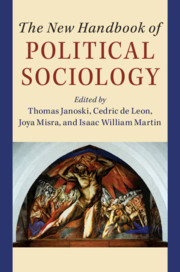Book contents
- The New Handbook of Political Sociology
- The New Handbook of Political Sociology
- Copyright page
- Dedication
- Contents
- Tables
- Figures
- Contributors
- Acknowledgments
- Introduction
- I Theories of Political Sociology
- II Media Explosion, Knowledge as Power, and Demographic Reversals
- III The State and Its Political Organizations
- IV Civil Society: The Roots and Processes of Political Action
- V Established and New State Policies and Innovations
- VI Globalization and New and Bigger Sources of Power and Resistance
- 36 Global Political Sociology and World-Systems
- 37 Liberalizing Trade and Finance
- 38 The Racial State in the Age of Racial Formation Theory and Beyond
- 39 Democracy and Autocracy in the Age of Populism
- 40 Transnational Social Movements
- Index
- References
37 - Liberalizing Trade and Finance
Corporate Class Agency and the Neoliberal Era
from VI - Globalization and New and Bigger Sources of Power and Resistance
Published online by Cambridge University Press: 22 February 2020
- The New Handbook of Political Sociology
- The New Handbook of Political Sociology
- Copyright page
- Dedication
- Contents
- Tables
- Figures
- Contributors
- Acknowledgments
- Introduction
- I Theories of Political Sociology
- II Media Explosion, Knowledge as Power, and Demographic Reversals
- III The State and Its Political Organizations
- IV Civil Society: The Roots and Processes of Political Action
- V Established and New State Policies and Innovations
- VI Globalization and New and Bigger Sources of Power and Resistance
- 36 Global Political Sociology and World-Systems
- 37 Liberalizing Trade and Finance
- 38 The Racial State in the Age of Racial Formation Theory and Beyond
- 39 Democracy and Autocracy in the Age of Populism
- 40 Transnational Social Movements
- Index
- References
Summary
Political sociology has an important role in explaining the history, development, and consequences of neoliberal globalization. Specifically, our methods and theory are equipped to address the role of states and the political economy in shaping processes and outcomes of globalization, but also to examine specific forms of collective action aimed at building neoliberal institutions – or challenging and transforming them. This chapter addresses the ways that the collective action of US corporate leaders ushered in neoliberalization through trade policy, closely interacting with state officials and institutions.
- Type
- Chapter
- Information
- The New Handbook of Political Sociology , pp. 973 - 1002Publisher: Cambridge University PressPrint publication year: 2020



